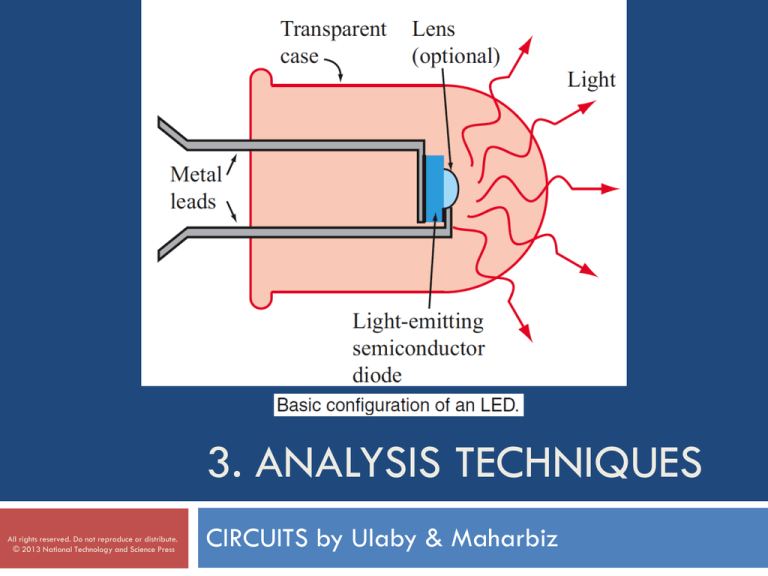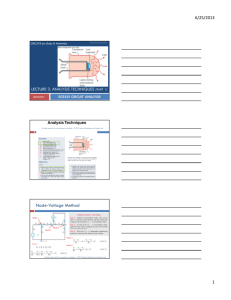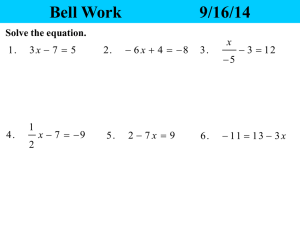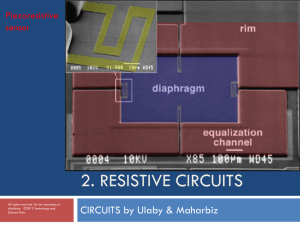
3. ANALYSIS TECHNIQUES
All rights reserved. Do not reproduce or distribute.
© 2013 National Technology and Science Press
CIRCUITS by Ulaby & Maharbiz
All rights reserved. Do not reproduce or distribute. © 2013 National Technology and Science Press
Node-Voltage Method
Node 1
Node 3
Node 2
Node 2
Node 3
All rights reserved. Do not reproduce or distribute. © 2013 National Technology and Science Press
Node-Voltage Method
Three equations in 3 unknowns:
Solve using Cramer’s rule, matrix
inversion, or MATLAB
All rights reserved. Do not reproduce or distribute. © 2013 National Technology and Science Press
All rights reserved. Do not reproduce
or distribute. © 2013 National
Technology and Science Press
Supernode
A supernode is formed when a voltage source connects two
extraordinary nodes
Current through voltage source is unknown
Less nodes to worry about, less work!
Write KVL equation for supernode
Write KCL equation for closed surface around supernode
All rights reserved. Do not reproduce or distribute. © 2013 National Technology and Science Press
KCL at Supernode
=
Note that “internal” current in supernode cancels,
simplifying KCL expressions
Takes care of unknown current in a voltage source
All rights reserved. Do not reproduce or distribute. © 2013 National Technology and Science Press
Example 3-3: Supernode
Solution:
Supernode
Determine: V1 and V2
All rights reserved. Do not
reproduce or distribute. © 2013
National Technology and Science
Press
All rights reserved. Do not reproduce or distribute. © 2013 National Technology and Science Press
Mesh-Current Method
Two equations in 2 unknowns:
Solve using Cramer’s rule, matrix
inversion, or MATLAB
All rights reserved. Do not reproduce or distribute. © 2013 National Technology and Science Press
Example 3-5: Mesh Analysis
Mesh 1
But
Hence
Mesh 2
Mesh 3
All rights reserved. Do not reproduce or distribute. © 2013 National Technology and Science Press
Supermesh
A supermesh results when two meshes have a current
source( with or w/o a series resistor) in common
Voltage across current source is unknown
Write KVL equation for closed loop that ignores branch with current source
Write KCL equation for branch with current source (auxiliary equation)
All rights reserved. Do not reproduce or distribute. © 2013 National Technology and Science Press
Example 3-6: Supermesh
Mesh 1
Solution gives:
Mesh 2
SuperMesh 3/4
Supermesh Auxiliary Equation
All rights reserved. Do not reproduce or distribute. © 2013 National Technology and Science Press
Nodal versus Mesh
When do you use one vs. the other?
What are the strengths of nodal versus mesh?
Nodal Analysis
Node Voltages (voltage difference between each node
and ground reference) are UNKNOWNS
KCL Equations at Each UNKNOWN Node Constrain
Solutions (N KCL equations for N Node Voltages)
Mesh Analysis
“Mesh Currents” Flowing in Each Mesh Loop are
UNKNOWNS
KVL Equations for Each Mesh Loop Constrain Solutions
(M KVL equations for M Mesh Loops)
Count nodes, meshes, look for supernode/supermesh
Nodal Analysis by Inspection
Requirement: All sources are independent current sources
All rights reserved. Do not reproduce or distribute. © 2013 National Technology and Science Press
All rights reserved. Do not reproduce or distribute. © 2013 National Technology and Science Press
Example 3-7: Nodal by Inspection
Off-diagonal elements
G11
@ node 1
@ node 2
@ node 3
@ node 4
Currents into nodes
G13
All rights reserved. Do not reproduce or distribute. © 2013 National Technology and Science Press
Mesh by Inspection
Requirement: All sources are independent voltage sources
All rights reserved. Do not reproduce or distribute. © 2013 National Technology and Science Press
Linearity
A circuit is linear if output is proportional to input
A function f(x) is linear if f(ax) = af(x)
All circuit elements will be assumed to be linear
or can be modeled by linear equivalent circuits
Resistors
V = IR
Linearly Dependent Sources
Capacitors
Inductors
We will examine theorems and principles that apply to
linear circuits to simplify analysis
Superposition
Superposition trades off the
examination of several simpler
circuits in place of one
complex circuit
All rights reserved. Do not reproduce or
distribute. © 2013 National Technology
and Science Press
All rights reserved. Do not reproduce or distribute. © 2013 National Technology and Science Press
Example 3-9: Superposition
Contribution from I0 alone
I1 = 2 A
Contribution from V0 alone
I = I1 + I2 = 2 ‒ 3 = ‒1 A
I2 = ‒3 A
All rights reserved. Do not reproduce or distribute. © 2013 National Technology and Science Press
Cell Phone
Today’s systems are complex. We use a block
diagram approach to represent circuit sections.
All rights reserved. Do not reproduce or distribute. © 2013 National Technology and Science Press
Equivalent Circuit Representation
Fortunately, many circuits are linear
Simple equivalent circuits may be used to represent
complex circuits
How many points do you need to define a line?
Thévenin’s Theorem
Linear two-terminal circuit
can be replaced by an
equivalent circuit
composed of a voltage
source and a series resistor
voltage across output with no
load (open circuit)
R Th R in
Resistance at terminals with all
independent circuit sources set to zero
All rights reserved. Do not reproduce or distribute. © 2013 National Technology and Science Press
All rights reserved. Do not reproduce or distribute. © 2013 National Technology and Science Press
Norton’s Theorem
Linear two-terminal circuit can
be replaced by an equivalent
circuit composed of a current
source and parallel resistor
Current through output with
short circuit
Resistance at terminals with all
circuit sources set to zero
How Do We Find Thévenin/Norton
Equivalent Circuits ?
Method 1: Open circuit/Short circuit
1. Analyze circuit to find
2. Analyze circuit to find
Note: This method is applicable to
any circuit, whether or not it
contains dependent sources.
All rights reserved. Do not reproduce or distribute. © 2013 National Technology and Science Press
All rights reserved. Do not reproduce or distribute. © 2013 National Technology and Science Press
Example 3-10: Thévenin Equivalent
How Do We Find Thévenin/Norton
Equivalent Circuits?
Method 2: Equivalent Resistance
1. Analyze circuit to find either
or
2. Deactivate all independent sources by
replacing voltage sources with short
circuits and current sources with open
circuits.
3. Simplify circuit to find equivalent
resistance
Note: This method does not
apply to circuits that contain
dependent sources.
All rights reserved. Do not reproduce or distribute. © 2013 National Technology and Science Press
All rights reserved. Do not reproduce or distribute. © 2013 National Technology and Science Press
Example 3-11: RTh
Replace with SC
Replace with OC
(Circuit has no dependent sources)
How Do We Find Thévenin/Norton
Equivalent Circuits?
Method 3:
All rights reserved. Do not reproduce or distribute. © 2013 National Technology and Science Press
Example
Example
All rights reserved. Do not
reproduce or distribute.
© 2013 National Technology
and Science Press
All rights reserved. Do not reproduce or distribute. © 2013 National Technology and Science Press
Example (cont.)
To find
All rights reserved. Do not reproduce or distribute. © 2013 National Technology and Science Press
Power Transfer
In many situations, we want to
maximize power transfer to the load
All rights reserved. Do not reproduce or
distribute. © 2013 National
Technology and Science Press
All rights reserved. Do not
reproduce or distribute. ©
2013 National Technology
and Science Press
Tech Brief 4: The LED
All rights reserved. Do not reproduce or distribute. © 2013 National Technology and Science Press
Tech Brief 4: The LED
All rights reserved.
Do not reproduce
or distribute.
© 2013 National
Technology and
Science Press
Tech Brief 4: The LED
All rights reserved. Do not reproduce or distribute. © 2013 National Technology and Science Press
BJT: Our First 3 Terminal Device!
Active device with dc sources
Allows for input/output, gain/amplification, etc
All rights reserved. Do not reproduce or distribute. © 2013 National Technology and Science Press
All rights reserved. Do not reproduce or distribute. © 2013 National Technology and Science Press
BJT Equivalent Circuit
Looks like a current amplifier
with gain b
All rights reserved. Do not reproduce or distribute. © 2013 National Technology and Science Press
Digital Inverter With BJTs
BJT Rules:
Vout cannot exceed Vcc=5V
Vin cannot be negative
Output high
Input low
Output low
Input high
In
In
Out
0
1
1
0
Out
All rights reserved. Do not reproduce or distribute. © 2013 National Technology and Science Press
Nodal Analysis with Multisim
See examples on DVD
All rights reserved. Do not reproduce or distribute. © 2013 National Technology and Science Press
Multisim Example: SPDT Switch
Summary
All rights reserved. Do not reproduce or distribute. © 2013 National Technology and Science Press








